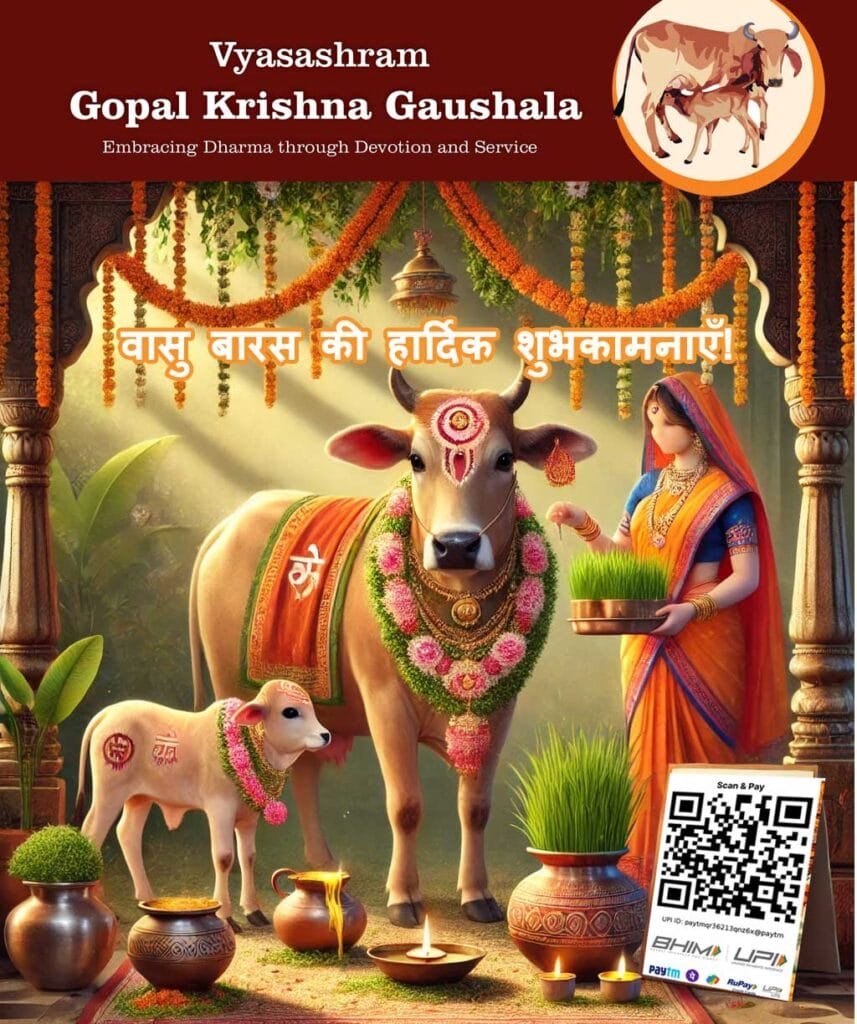
Govatsa Dwadashi is a beautiful Hindu festival that pays homage to cows, honoring their essential role in our lives. Celebrated primarily in Maharashtra and parts of North India, this festival marks the start of Diwali’s five-day festivities and is dedicated to the care and respect of cows, often regarded as a symbol of nourishment, abundance, and prosperity in Hindu culture.
What is Govatsa Dwadashi?
Govatsa Dwadashi, also known as Nandini Vrat, falls on the twelfth day (Dwadashi) of the dark fortnight (Krishna Paksha) in the Kartik month of the Hindu lunar calendar. This festival begins the Diwali season with gratitude and reverence for cows, emphasizing their invaluable role in our lives. According to Hindu beliefs, cows are divine animals, often representing the nurturing aspects of nature and seen as bestowing wealth and well-being.
Why is Govatsa Dwadashi Important?
Cows hold a significant place in Hindu culture and are cherished for their contributions to daily life. They provide milk, which nourishes people, while their dung is used in agriculture, cooking, and traditional medicines. Govatsa Dwadashi serves as a reminder to respect and protect these animals that give us so much. It is also a day when people pray for family happiness, especially for the well-being of children, aligning with the nurturing essence that cows symbolize.
Who Celebrates Govatsa Dwadashi?
Govatsa Dwadashi is celebrated by families, especially in rural areas where cows are a central part of life. Farmers, cowherds, and people involved in agriculture and animal care observe this day with rituals. Married women in particular, many of whom follow the Govatsa vrat (fasting) on this day, worship the cows and seek blessings for their children’s health and prosperity.
How is Govatsa Dwadashi Celebrated?
Celebrations for Govatsa Dwadashi are simple yet meaningful, involving specific rituals and offerings:
- Decorating Cows and Calves: Cows and calves are bathed and adorned with turmeric, vermilion, and flowers. This act is a symbolic gesture of love and respect for these animals.
- Offering Special Prasad: Devotees prepare offerings of green gram, wheat, and other grains to feed the cows. It’s believed that feeding cows on this day brings good luck and prosperity.
- Govatsa Vrat: Many married women observe fasting as part of Govatsa vrat, praying for the well-being of their family, particularly their children. After completing the rituals, they offer blessings to their family.
These rituals are usually performed early in the morning or in the temple courtyards, where people gather and collectively worship.
Spiritual Significance of Govatsa Dwadashi
Cows are called “Kamadhenu” in Hindu scriptures, meaning they are wish-fulfilling creatures. On Govatsa Dwadashi, worshipers treat cows with reverence, remembering their role in the balance of life and as a representation of Mother Earth. This day reinforces the belief that all creatures deserve love and respect.
Where is Govatsa Dwadashi Celebrated?
Though Govatsa Dwadashi is most popular in Maharashtra, it’s also celebrated in neighboring regions like Gujarat and Madhya Pradesh. In villages, temples and gaushalas (cow shelters) become the focal points of the celebrations, where communities come together to honor and worship the cows with collective rituals and prayers.
When is Govatsa Dwadashi Celebrated?
Govatsa Dwadashi is celebrated on the twelfth day of Kartik’s Krishna Paksha, a day before Dhanteras. The date varies annually, usually falling in late October or early November, just as Diwali festivities begin.
Govatsa Dwadashi Rituals and Practices
- Prayers and Offerings: The day begins with prayers, offerings, and the feeding of cows with nourishing food. Cows are considered sacred animals, embodying kindness and compassion.
- Govatsa Vrat: Many people observe a fast, particularly women, who pray for family happiness and the health of their children. The fast is symbolic of gratitude and a means of seeking blessings.
- Community Gatherings: Govatsa Dwadashi celebrations bring people together, often forming a community celebration of devotion and thankfulness.
Why Should We Celebrate Govatsa Dwadashi?
Govatsa Dwadashi reminds us of the importance of respecting and caring for all creatures. By honoring cows, we acknowledge their role in sustaining life and their gentle, giving nature. Celebrating this day reinforces our relationship with nature and helps foster a spirit of compassion and care for animals.
Conclusion
Govatsa Dwadashi is not only a festival but a celebration of the bond between humans and nature. As we honor cows, we recognize the wisdom of ancient practices that teach us to value and respect all forms of life. Govatsa Dwadashi, with its message of love and gratitude, brings people together to begin Diwali on a note of reverence and compassion.
Celebrating Govatsa Dwadashi is a way to remember our roots and the value of gratitude towards nature and animals. It’s a day filled with respect, devotion, and a reminder of the sacred connection we share with all living beings.